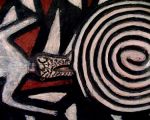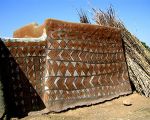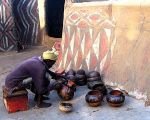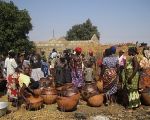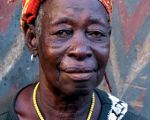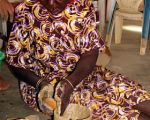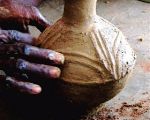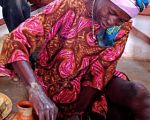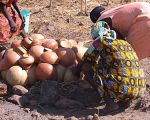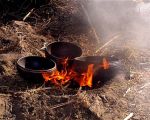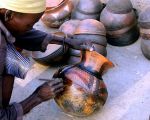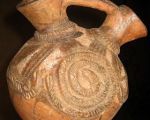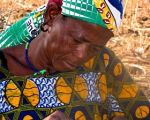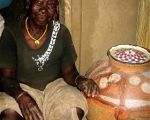The Potters of Sirigu
by Ann Schunior
I should not have been surprised that the women of Northern Ghana are imaginative potters. When I first saw photographs of their houses, my immediate impression was that they live in large, beautifully decorated pots. I'm a potter and I see the world in terms of pots. The houses are made of mud, and mud and clay have a lot in common. Like clay, mud can be sculpted, incised and molded into relief decorations. Dried mud - adobe - can be painted. When I visited the potters, what I learned was that the methods and materials they use to decorate their houses and pottery are exceedingly similar.
The houses
Painted adobe houses used to be more common in Northern Ghana. Today they can be seen primarily in two areas near Bolgatanga where community organizations have been formed to promote house decorating. VOPAC - Village of Pottery, Art and Culture - is about 5 miles from Bolgatanga. Sirigu is about 15 miles from Bolga and the home of SWOPA, Sirigu Women's Organization of Pottery and Art. Family compounds are built around shared courtyards circled by high mud walls that provide privacy for the family and enclosure for the household animals. Both the houses - inside and out - and the surrounding walls are decorated.The surface of a wall to be painted is built up in layers. The bottom layer is sculpted with relief decorations. Each layer is composed of a different type of earth, covered with a thin protective layer of cow dung in water and polished. The final layer is painted with designs, polished, and covered with a solution of dawa-dawa, a varnish made from the seeds of a local locust tree. Only three colors are used for the designs, all earth based pigments. Red comes from a local stone, black pigment from a stone from Burkina Faso that is purchased in the market, and white comes from a chalky stone that is rubbed over the final surface. Deep incised grooves can outline the patterns or fill in detail. The compacting from intensive smoothing, the inclusion of cow dung, and the coating of dawa-dawa create a surface that is strong and fairly water resistant. The surface will last about five years before it needs repainting.
To the eye of an outsider, designs are bold and geometric - triangles, diamonds, lozenges - arranged in horizontal bands and interspersed with animals in relief. To the community, the patterns are composed of a visual vocabulary steeped with meaning. When a woman decorates her house, she's telling the world who she is and is trying to provide protection through images such as the python and crocodile.
The pottery
If house decorating is done as a statement by each woman of who she is and of her place in the community, pottery is a commercial endeavor that provides income. Although a few men pot, most potters are women. Even with the introduction of plastic containers, pottery is still used to hold water, grain, for general household use and ceremonial vessels.The pots are made from coils, starting with a ring with a ball of clay pressed in to form the bottom. As the walls get higher they are shaped and smoothed with a piece of calabash. Before the pot is dry, relief decorations may be added and patterns incised in the clay, much as are done to the house walls. The pots may be decorated with a dark brown stain before being dried for a week.
Firing is a simple process. In a field near a family compound, the pots are carefully stacked on a bed of millet straw, covered with bundles of straw and set on fire. A firing may take a couple of hours. When the women think the pots are ready, the fire is allowed to die down. With the straw still smoldering, hot pots are pulled from the fire.Some pots are quickly put on more straw, which catches fire. The smoke from the fire is embedded in the clay, making the pot permanently black. Other pots are taken to women who paint more patterns, often following the lines that were incised earlier. The white, chaulky stone used to color the house walls is also used to create designs on the fired pots. Some pots get no additional attention, their only decoration being the marks left by the fire. The pots, like the houses, may be covered with dawa-dawa to make them less porous.
SWOPA
Until 1997 the potters of Sirigu sold their pots the same way other rural potters sell their wares. They would stack them on their heads and walk to the market. If they started walking at 2:30 in the morning, they could be at the Navrongo market by opening time. At the end of the day, if they haven't sold enough pots, they would barter the pots for food and other essentials, set that on their heads and walk back home. Fewer and fewer houses were being painted. It was too expensive and time consuming for the women. Sirigu was losing more than a traditional craft. House painting has been a social glue for the community, and that cohesion was being lost.
In 1997 the Sirigu Women's Organization of Pottery and Art (SWOPA) was formed to bring income and recognition to the potters. Now with 150 members, it has become a model for community development. Recognizing that tourists came to Sirigu to see the painted houses and that they would be willing to pay far more for the pottery than the women get in the market, SWOPA began buying pottery from the women to sell to outsiders. SWOPA pays the potters more than they had ever gotten, and raises the prices yet more to support the organization. They have a gallery to display (and sell) the work. They provide tours of the houses, teach workshops in pottery and basket making, and run a guest house so that visitors can stay and enjoy the generous hospitality of the community.
Photo Credits:
all photographs by Ann Schunior
More information about SWOPA is available at their web site.
See also a video Ann made about efforts to create economic opportunity and preserve the cultural heritage of women potters in northern Ghana.

